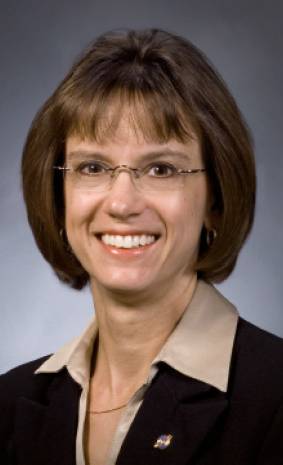Society News
Name: Barbara Esker FRAeS, 54 (although I would advise against asking any woman her age!)
 Location: My position is with NASA Headquarters in Washington, DC, but I have a ‘duty station’ at the NASA Glenn Research Center in Cleveland, Ohio, which means that I have an office at each location and, prior to the pandemic, I travelled back and forth quite a bit.
Location: My position is with NASA Headquarters in Washington, DC, but I have a ‘duty station’ at the NASA Glenn Research Center in Cleveland, Ohio, which means that I have an office at each location and, prior to the pandemic, I travelled back and forth quite a bit.
Job title: Deputy Director, Advanced Air Vehicles Program within the NASA Aeronautics Research Mission Directorate.
What inspired you into aerospace? My dad cultivated an interest in aviation. He loved aircraft but never had the opportunity to work directly in this field. Fortunately, he found opportunities to explore this interest. I remember going to the US Air Force Museum in Dayton, Ohio, when I was about six years old and we would attend local airshows when we had the chance. Additionally, I remember visiting the NASA Kennedy Space Center as one part of a family vacation to Florida. My very first experience flying was in a towed glider aircraft when I was about seven years old.
What is the best thing about your current role? The best thing about my current role is the really amazing people with whom I have the opportunity to work closely. They are exceedingly smart and passionate persons who are truly making a positive impact in the field of aerospace and aviation. I feel truly humbled to be part of their teams and to consider many of them my closest friends.
What made you join the Royal Aeronautical Society? A highly respected colleague recommended that I consider joining, since the Society is highly regarded for their commitment to the advancement and growth of aerospace and aviation knowledge and workforce. RAeS membership is complementary to the AIAA (American Institute for Aeronautics and Astronautics) and is an opportunity to continue to grow my engagement with the international aerospace community and further develop relationships and friendships with new peers around the globe.
What do you hope to get out of your membership with the RAeS? I look forward to meeting and networking with new colleagues and continuing to learn about this ever-expanding field. Having access to both RAeS-sponsored events and publications will be exceedingly valuable.
What three items would you take with you to the space station? A picture of my immediate family, a picture of my extended family and a means of recording my experiences on the space station. What’s your favourite aircraft? F-35B (STOVL variant) – since my first position at NASA involved getting data to help answer some of the very basic science and technology questions associated with the vertical lift propulsion systems.
Who is your biggest inspiration? Early inspiration comes from my parents. In college, Mom was the only woman in chemistry, graduating with a bachelor’s degree in 1964. Dad attended evening college for 11 years to earn his degree while I was young. A college professor (Dr Paul Lam) provided support/inspiration during my undergraduate and graduate education, and he recommended sending a résumé to NASA. Early in my career, two colleagues (Jack McArdle and Albert Johns) were really inspiring. Both were outstanding aerospace researchers and demonstrated the upmost respect for their teams. Working with them, I witnessed the profound importance of valuing all team members’ respective contributions.
Piece of advice for someone looking to enter your field? Really embrace the concept of the multi-disciplinary solution space – recognise that, given the multi-disciplinary complexity of these aerospace systems, there is no way that you can know it all. You must be able to work well with, and truly value, persons with expertise outside of your own area including expertise from outside of engineering. Innovative solutions often emerge from the confluence of multiple disciplines. Finally, recognise the importance of understanding the broader context for your work – this means having an accurate understanding of the societal, economic, and technical drivers and implications of the system on which you work.